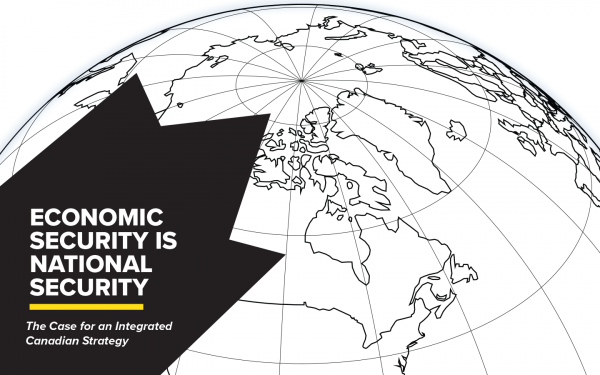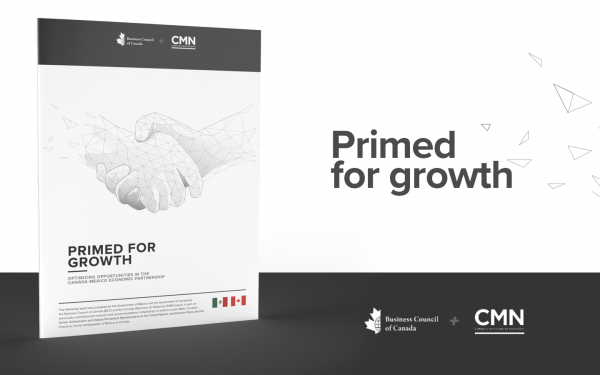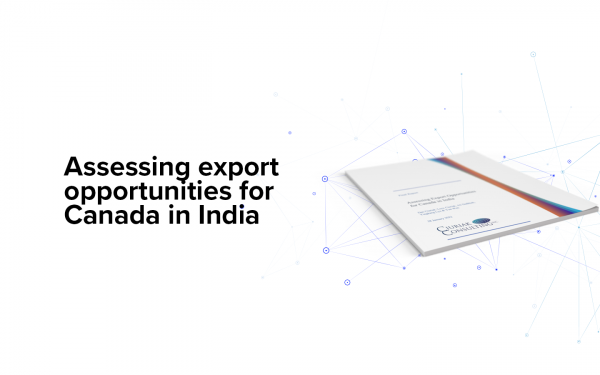Made in the world: defragmenting rules of origin for more efficient global trade
Executive Summary
In the past, goods were manufactured in one country and exported to another. Today, cross-border supply chains encompass multiple enterprises located in various sites around the world. Three-quarters of international trade, close to 15 trillion dollars, moves along mega-regional value chains in Europe, North America and Asia.
There is no longer a simple answer to the question: “Where was this product manufactured?” Trade realities have changed but our approach to rules of origin – in other words determining where a product is from – has not.
In the context of free trade deals, rules of origin determine whether or not a producer will have to pay duties and at what level. With over 300 trade agreements in force today, different rules of origin in each agreement increase complexity and exporters face increasing difficulties in proving origin.
Complex rules create regulatory fragmentation, exclusion and discrimination. There can also be stiff penalties for errors in identifying origin. As a result, some exporters are foregoing the benefits negotiated in free trade agreements. Different ways of assessing rules of origin are also costly. It is estimated that rules of origin compliance costs run as high as five percent of the value of the finished goods. Simplifying and properly managing preferential rules of origin is thus an opportunity to lower the cost of goods paid by consumers.
Rules of origin must be pulled back from the brink of complexity. Some immediate steps should be taken to improve the administration and effectiveness of origin rules in global trade. These are:
- simplify rules in existing agreements and establish new rules to join free trade areas together;
- establish a common global database of origin information standards; and
- reduce the potential penalties associated with errors in origin disclosure.
With an economy largely dependent on imported inputs, Canadian firms must lead the way in simplifying rules of origin across trade agreements. Canada should become a global leader in the design of origin rules that are efficient, and that complement emerging customer demands for reliable product information.

Introduction
To many bystanders, […] renegotiating Regional Trade Agreements (RTAs) and reconciling differences across regimes either at the regional or global levels might seem like opening a Pandora’s Box of endless troubles. Nonetheless, this effort to defragment fragmented RTAs is worth being made in order to bring the diverging regimes up to date with the commercial and technological realities of the contemporary and upcoming world (Choi 2009, 18).
In the past, goods were manufactured in one country and exported to another. Today, cross-border supply chains encompass multiple enterprises located in various sites around the world. There is no longer a simple answer to the question: “Where was this product manufactured?” Trade realities have changed but our approach to rules of origin has not.
There is an urgent need for a debate surrounding rules of origin and their use. With the World Trade Organization (WTO) negotiations at a standstill, regional free trade agreements are carrying the momentum of global trade liberalization. Mega-regional agreements such as the Trans-Pacific Partnership (TPP) and the US-EU Transatlantic Trade and Investment Partnership (TTIP) could soon become major sources of rulemaking for the global trading system, including systems of preferential rules of origin.
Baldwin (2012, 12) points out that deep integration within mega-regions risks creating regulatory fragmentation, exclusion and discrimination. Nowhere is the issue of regional fragmentation more troublesome than in the administration of rules of origin. For example, Canadian officials negotiating auto sector rules of origin in the recent Comprehensive
Economic and Trade Agreement (CETA) with the European Union were challenged to find a way to create real benefits for Canadian exporters to the EU market given Canada’s auto supply chain is tied to the United States and Mexico. The Canada-US free trade deal, and then NAFTA, have created truly North American automobile supply chains (see Box 3 on page 14).
The reality of multiple and complex rules of origin procedures are already facing negotiators. For example, Asia-Pacific nations such as Australia, New Zealand and Japan are simultaneously negotiating the TPP and the Regional Comprehensive Economic Partnership (RCEP), a negotiation between the 10 ASEAN member states and its FTA Partners. While the goals of RCEP promise to harmonize and consolidate rules of origin, there are at least 22 different rules of origin in force among the RCEP parties, of which only about 30 percent of tariff lines share common origin rules (Menon 2013). Given the lack of progress in the WTO Doha Round, there is an urgent need for leadership to simplify and streamline rules of origin.
It is estimated that three-quarters of international trade, close to 15 trillion dollars, moves along mega-regional value chains in Europe, North America and Asia (Baldwin 2012). Notwithstanding their distinct geographies, these production networks are largely inhabited by the same multinational corporations and, in the absence of international norms, they are seeking some element of origin commonality.
As different rules of origin are layered on with each new trade agreement, exporters face increasing difficulties in proving origin. In many cases, exporters may sacrifice the preferential market access benefits conferred by regional agreements because the costs of administering rules of origin are too high, choosing instead to use the WTO most-favoured nation rate of customs duties. The challenge for policy makers, therefore, is how to reduce origin costs, improve free trade agreement connectivity and increase origin utilization. (Baldwin 2012).
Preferential rules of origin (those that confer a benefit within a free trade agreement) are closely linked to trade policy mechanisms such as market access, tariffs, quotas, customs fees, and contingent protection. But non-preferential rules of origin that provide information about the national and enterprise-level origin of inputs are becoming increasingly important. For example, more consumers are demanding verification that the products they consume come from safe, high-quality and ethical sources.
Thus, it is clear that while the rules of origin as they apply to trade must be made less burdensome, they cannot be abandoned. Rather, we must redouble our efforts to develop a robust and transparent origin system to ensure that producers, consumers, and policy makers have the information they need to make informed choices. This report examines these issues, and provides recommendations to advance the dual goals of efficiency and traceability.

What are Rules of Origin?

Rules of origin determine whether or not a product receives preferential access – namely duty-free or nearly duty-free tariff treatment – in an export market. These rules can mean the difference between paying duties (which can be as much as 300%) or paying no duties at all.
Trade agreements determine what type of rules of origin will allow a good to qualify for preferential treatment. Today there are hundreds of different trade agreements in force in the world. Although most global trade uses the most-favourednation (MFN) rate of duty in the WTO, RTAs such as the North American Free Trade Agreement (NAFTA) and CETA provide better-than-MFN rates if the exporter can prove that the final product “originates” within the area covered by the RTA.
Preferential origin determination can be costly, and faulty origin declarations can result in serious sanctions and penalties. The paperwork – including supplier lists, bills of materials and purchase orders – can run to hundreds of pages for each product.
The easiest origin scenarios are those where a good is wholly produced or obtained within the territories covered by the RTA. It gets more complicated when product inputs come from outside the region. When inputs come from outside, imported inputs must be ‘sufficiently worked or processed’ or
‘substantially transformed’ in order for the finished product to be eligible for reduced or duty-free treatment.
Broadly speaking there are three basic methods that can be used to achieve substantial transformation: tariff shift, value percentage criteria and specified input/process (see Box 1).
Whichever one of these methods is selected becomes the rule of origin for a particular product in a particular agreement. Although there is an emerging consensus that tariff shift is the preferred way to express substantial transformation, the NAFTA example in Annex 2 illustrates how challenging this can be.
Why use Preferential Rules of Origin?
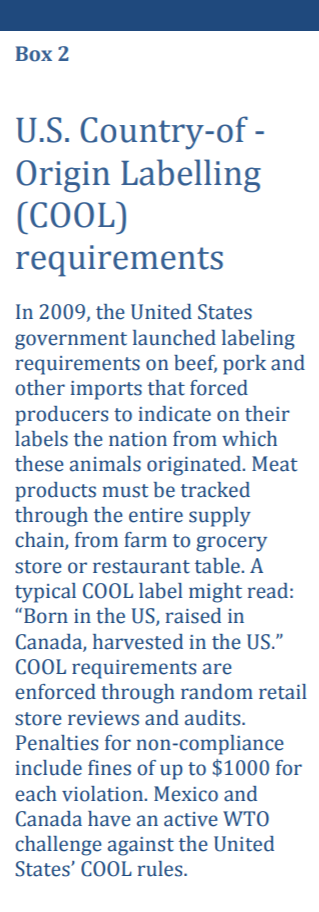
Preferential rules of origin help agreement signatories to enjoy the benefits of their negotiations and to prevent trade deflection. Trade deflection occurs when goods are shipped through a low-duty country in order to gain access to a higherduty market. For example Mexico and Paraguay have an RTA but Paraguay and Canada do not. Therefore, the NAFTA rule of origin prevents goods from Paraguay from being transshipped through Mexico and entering Canada duty free.
A preferential certificate or declaration of origin acts as a passport for goods and declares that the subject goods are indeed “originating” and therefore should enjoy duty reduced or duty free treatment when traded between free trade partners.
Non-preferential rules of origin
Non-preferential rules of origin are used to provide information and statistics for quotas, anti-dumping and anti-circumvention measures and other uses. The most familiar expression of non-preferential rules of origin is their contribution to product labeling: Made in Canada, Product of
China, etc. The US Department of Agriculture’s contentious Country of Origin Labeling regime is a well-known example of non-preferential rules of origin in action (See Box 2).
The first major difference between preferential and non-preferential rules of origin is that while the former examine a good’s regional content (e.g. NAFTA content), non-preferential rules seek to determine a good’s country of origin – a more detailed and painstaking job. However, the information elicited from non-preferential origin determination can also contribute to the growing demand for consumer information.
Traceability and the enlightened consumer
Companies around the world are using traceability to create value for themselves and their clients. One of the most prominent drivers behind the trend is the group of enlightened consumers who are demanding reliable sources of product information in order to confirm product claims and provenance.
This type of consumer is willing to pay a premium for products that meet the buyer’s quality, diversity, environmental, social and ethical standards. These consumers also want to ensure that undesirable product constituents have been excluded from their purchases and they want the manufacturer or retailer to accurately and transparently demonstrate that these inputs are not present in the finished article.
Some examples of private sector and non-governmental initiatives to meet the social license demands of consumers are:
- Fair Trade certification, ensuring that coffee and other products meet certain standards of ethical, labour, and environmental sustainability;
- the GoodWeave (formerly Rugmark) label, certifying that hand-knotted rugs did not use child labour in the production process;
- the EcoLogo Program, certifying that the product provides tangible human health and environmental benefits; and
- the Walmart “Love Earth” jewelry line, that allows buyers to go on-line to trace the path of the product from mine to store.
Governmental and inter-governmental initiatives include:
- the US Lacey Act, which requires that imports of plant and plant products include assurances that the product was not obtained from protected or endangered sources;
- the EU IUU rules, that prevent the export of fish and seafood obtained through illegal, unreported and unregulated fishing;
- the EU REACH program, which protects human and environmental health from the harmful effects of chemicals;
- the US Department of Labor request for information concerning goods produced in foreign countries by child labour and forced labour.
- the Kimberley Process, a joint governmental and industry initiative to stem the flow of conflict diamonds.
As will be discussed later in this paper, the challenges of information gathering and management create difficulties in the preferential rules of origin regime, leading producers to under-utilize the trade benefits available to them. However, rising consumer demand for origin data is generating greater public awareness and demands for government action. This should help generate political will and new resources. Rather than a hindrance to global commerce, the “enlightened consumer” might actually be a boon to more transparent and efficient trade flows.

The Important Rules of Origin for Canadian Business
The Harper government’s Global Markets Action Plan released in November 2013 concludes that advancing free trade agreements is critical to Canada’s economic health. Canadian traders have access to more than half of the total global marketplace through the NAFTA and the CETA agreement in principle. Properly negotiated and implemented, rules of origin can facilitate the duty free import of inputs that will make Canada’s exports more competitive.
As a small, open economy with growing participation in global supply chains, few products are manufactured wholly within Canada’s borders. Thus, it is vital that rules of origin be transparent, easy to administer, and permit Canadian manufacturers to draw inputs from the widest range of sources.
Rules of origin are important at both the policy level and the enterprise level. A company that does not have a comprehensive origin strategy cannot take advantage of duty-free opportunities. This could lead to lost sales and suppressed profitability, especially if their competitors are more successful at origin management.
Failure to manage origin operations carefully can lead to costly origin verifications that usually take place long after the goods have been imported or exported duty free and sold to customers on that basis. Origin literacy is a prerequisite skill for any enterprise, small or large, in order to reap the potential benefits of free trade agreements.

Problems and Challenges
Primary products sectors, such as agricultural and mining outputs that are ‘wholly produced’ in a free trade area have the fewest difficulties in terms of origin. Most of the challenges are in manufacturing sectors such as automotive, processed foods, clothing and industrial machinery. The major impediments are complexity and non-uniformity; administrative costs (and potential penalties); an imbalance of rights and responsibilities between importers and exporters; and the use of origin as a protectionist tool.
Complexity and non-uniformity
Origin complexity is the major reason why some firms, particularly small and mediumsized enterprises, prefer to use MFN rates rather than the lower rates of duty available through RTAs. In the early 1990s there were roughly 70 free trade agreements in the entire world. Today, there are well over 300. Keeping track of and complying with all of the agreements to which Canada is a party is a big job. To make matters worse, despite efforts by such organizations as the WTO and World Customs Organization, there are no international standards for preferential or non-preferential rules of origin. Origin is the uncharted territory of international trade.
Preferential and non-preferential origin obligations do have some discouraging commonalities. Both are subject to stiff enforcement and penalties. For example Toyo Ink was fined some $45 million by the US Department of Justice for misdeclaring the country of origin for ink.
Cases like this are generating ‘preference paranoia’ and importers are refusing to claim preference at the time of entry. Many corporations are simply not willing to claim a benefit that might be overturned years later, requiring not only repayment of the duty benefits but also interest and penalties
Costs
It is estimated that the cost of origin compliance and the associated fixed costs of origin bureaucracy run as high as five percent of the value of the finished goods. Training and awareness programs can provide some assistance with administrative costs but, notwithstanding these efforts, the greatest priority is to simplify and streamline global origin regimes.
Imbalance of rights and obligations between exporters and importers
One of the central administrative difficulties associated with origin is the fundamental imbalance of rights and obligations between exporters (or producers) and importers. In most transactions, it is the exporter/producer who certifies the origin but it is the importer who is legally and financially responsible if the origin certification is found to be inaccurate. Both preferential and non-preferential rules of origin are affected by this imbalance, especially in the context of “third-country” certification and verification challenges. It is critical that all parties have detailed knowledge about how and where a good is produced.
Use of origin as a protectionist tool
Non-preferential rules of origin and country of origin requirements have co-evolved with free trade agreements resulting in contentious practices such as US Country of Origin Labelling for meat (see Box 2 on page 7) and local preference schemes such as Buy American.9 While the goal of free trade agreements is to open national markets, these market-closing measures attempt to impose national interests across multi-country supply chains.
Origin labelling and local content requirements do not technically deny foreign suppliers the benefits specifically listed in a trade agreement, but they disrupt trade by distorting price signals, affecting the decisions of buyers, or creating administrative burdens that makes the choice of a foreign supplier difficult or impossible.

Lessons Learned from the NAFTA
The NAFTA product-specific rules of origin are often criticized for being overly restrictive. Even though many of them might have been relevant in the early 1990s when they were negotiated, market conditions and origin regimes have evolved significantly since then. However, one NAFTA mechanism, the NAFTA Working Group on Rules of Origin, has made a significant contribution to origin facilitation. The group, operating under the auspices of the NAFTA Free Trade Commission, is now working on its fourth set of origin simplifications. Because of this simplification, North American producers are able to have their longer and more internationalized supply chains recognized in the NAFTA rules of origin. This renewal process has helped to keep the NAFTA rules relevant and useful and should serve as a model for other agreements.
Mechanisms for improving efficiency
Compliance with rules of origin can affect the sourcing and investment decisions of companies. If the optimal input mix for a firm involves the use of imported inputs from countries that are not part of the RTA, the firm will have to shift from a lower to a higher cost source in order to make use of the preferential tariff benefits of the RTA. If the cost difference exceeds the size of the tariff preference, then the firm is better off sourcing from outside of the RTA region and paying the MFN tariff (Choi 2009, 8). De minimis exceptions for inputs in short supply and the ability to cumulate inputs from a partner may help to mitigate the restrictions imposed by rules of origin.
De minimis exceptions
Generally speaking, products that are in short supply, i.e. difficult or impossible to source locally, are treated differently from other imported inputs in order not to prevent products with scarce inputs from achieving originating status. This is a real concern when a very small percentage of inputs can mean the difference between achieving substantial transformation or not.
The NAFTA, for example, contains a de minimis provision that allows most goods to qualify as originating provided such materials are not more than seven percent (in most cases) of the transaction value or total cost of the goods.
Cumulation and cross-cumulation

Cumulation is based on the principle that materials considered to be originating in one country within a free trade trade bloc should be considered to be originating by other countries in the same bloc. Use of cumulation and extended -cumulation helps to overcome some of the problems assocated with disconnected free trade agreements. For example, a Canadian bicycle tire company sources tubes from Mexico. When exported to the United States, the Canadian company can claim both rims and tubes as NAFTA originating content. Note, however, that cumulation only applies to originating products and materials not, for example, to Mexican imports of Chinese tubes.
Extended-cumulation can occur when countries have overlapping trade agreements but all countries are not in a single block. For example, Canada has free trade agreements separately with Peru and Colombia and these two countries have an agreement with each other. Under the terms of the Canada-Peru FTA, Peru can ship Pima cotton yarn to Canada duty free but, if Peru shipped the same cotton yarn to
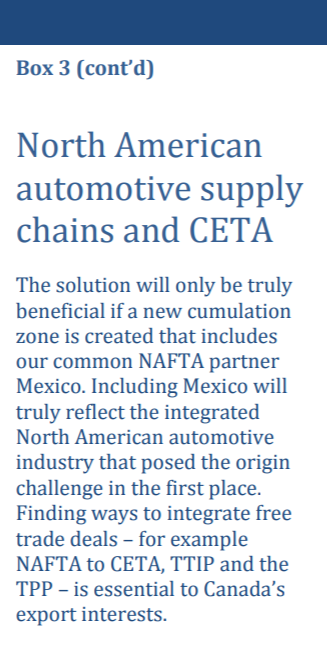
Colombia to be made into a shirt, the resulting shirt may not qualify for preferential tariff treatment under the Canada-Colombia FTA. Using extended-cumulation, Canada could import the Colombian shirts made with Peruvian yarn and both components would be considered originating content.
Canada is an international leader in promoting cumulation among common trading partners. It has laid the groundwork with its trading partners to allow the cumulation of all inputs and processes among common preferential trade parties, as long as the applicable rule of origin between the last exporter and the final importer is satisfied within the territory of the common FTA parties. This uniquely Canadian form of extended-cumulation is known as cross-cumulation. Provisions for cross-cumulation are written into many of Canada’s agreements with Israel, EFTA, Peru, Colombia, Jordan, Chile, Honduras and Panama (Ticon et al. 2013, 30). However, the effective use of these provisions requires negotiations with the external country involved in the transaction.
Since the US has not yet adopted cross-cumulation its use in this hemisphere is limited. More widespread adoption of extended-cumulation is evident in the European Union, in particular through the Pan Euro-Med rules of origin.
Although cumulation and cross-cumulation can help to multilateralize regionalism by increasing FTA connectivity, there are also administrative problems associated with these mechanisms. The first challenge relates to the information and records required to establish origin.
Certifying originating goods is relatively straightforward. The difficulty lies when one product is used as an input for another product and it becomes necessary to maintain adequate origin records not only from previous suppliers but also from previous countries that are members of a cumulation arrangement.
The second challenge is that customs authorities, particularly in the developing world, often lack the resources even to verify information from the last country of export let alone all previous countries. As well, the customs department in the country of final import most likely also lacks the authority to verify the preferential claim beyond the most-recent exporter,
putting the status of inputs from prior jurisdictions into question.

Recommendations
- Simplify rules in existing agreements and ensure that the rules of origin commitments in new free trade agreements ‘dock on’ to existing agreements.
For example, TPP rules of origin should be consistent with NAFTA rules, since all NAFTA signatories are also in TPP. The rules of origin in the pending US-EU free trade agreement should be consistent with both the NAFTA and the Canada-EU agreement
- Establish a common database of origin information standards.
A common, international database of origin records would effectively create a genealogy from which to prove origin not only from the last country of export but all preceding generations of exports. The
database could be managed by designated authorities such as chambers of commerce or customs brokers, both of whom are licensed by government authorities and subject to monitoring and sanctions. The concept of sharing and recognizing certified origin data has already been accepted under NAFTA.
- Remove penalties in exchange for disclosure.
Customs authorities have limited resources to verify origin and extremely limited information. When they do investigate origin, it is usually against a very small sampling of preferential imports and it is done on a transaction-by-transaction basis. This process is resource intensive for both traders and customs authorities. Under these circumstances, there is the possibility of creating a win-win situation if governments were to eliminate contingent origin liability, except in cases such as fraud and/or gross negligence, in exchange for full disclosure of origin data.
Full supply chain transparency in exchange for the removal of penalty and duty responsibilities would create a new form of origin certification that more accurately reflects the reality of ‘Made in the World.’ This scenario would supply resource-constrained customs authorities with much more information, improve origin risk assessment and overcome the jurisdictional challenges associated with cumulation. Moreover, the collection of such a detailed and extensive origin data set, when combined with ‘big data’ analytics would be a tremendous breakthrough for traceability and consumer information.
- Support the development and use of origin insurance.
In addition to reforms to contingent liability (above), origin insurance could also help to relieve importers from the financial burden of inaccuracies from data supplied by exporters, chambers, or other sources.
- Canadian leadership in origin best practices.
As a small, open economy, Canada has long taken a leadership role in origin innovation and efficiency. The next step should be Canadian support for the development of a set of model origin rules and administrative practices. These rules would set an optimal benchmark independent of any preferential trade negotiation. The model rule initiative will require private sector cooperation in order to be successful. However, these efforts will allow for more meaningful private sector consultations on origin issues.

Conclusions
While rules of origin will continue to be a prerequisite for the right to utilize marketopening trade agreements, it is possible to make them less burdensome, thereby increasing the efficiency of cross-border supply chains.
Mastering the requirements of preferential origin can have significant benefits for businesses. By taking the steps required to determine whether or not a product originates within a preferential trading area, companies accrue a critical mass of supply chain data that can be used to fulfill other traceability tasks, including making a product more attractive to discriminating consumers who are willing to pay higher prices for particular product attributes.
Reducing the liability burden for misdeclaration will immediately improve the quality and quantity of available origin data. This influx of new data must be managed within a reliable, accessible international system. Canada should continue to play a leadership role in developing a new origin regime that fosters cross-border information sharing, capacity building and best practices.
References
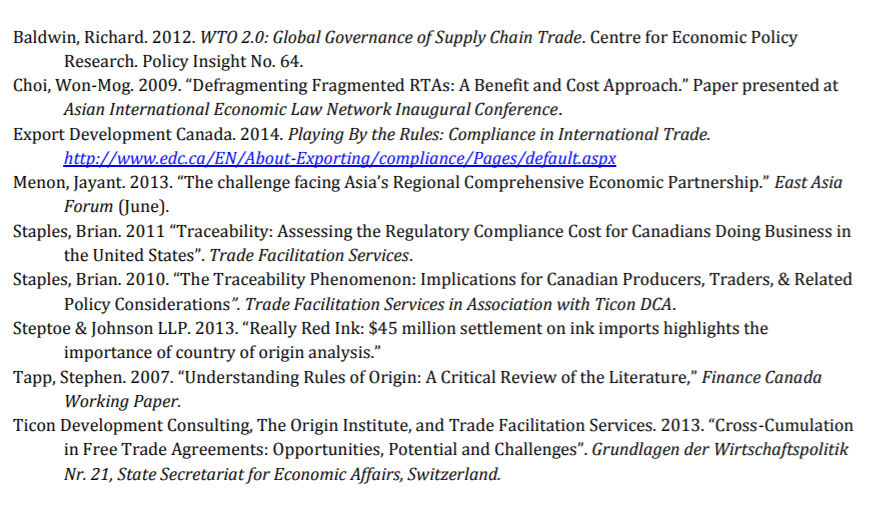
Annex 1: Current Canadian FTA Initiatives
FTAs in Force
Canada – Panama – Brought into force: April 1, 2013
Canada – Jordan – Brought into force: October 1, 2012
Canada – Colombia – Brought into force: August 15, 2011
Canada – Peru – Brought into force: August 1, 2009
Canada – European Free Trade Association – Brought into force: July 1, 2009
Canada – Costa Rica – Brought into force: November 1, 2002
Canada – Chile – Brought into force: July 5, 1997
Canada – Israel – Brought into force: January 1, 1997
North American Free Trade Agreement (NAFTA) – Brought into force: January 1, 1994
Canada – US Free Trade Agreement (CUSFTA) – Brought into force: January 1, 1989 (superseded by
NAFTA, which includes Mexico)
FTAs – Signed
Canada – Honduras – November 5, 2013
FTA Negotiations Concluded
Canada – European Union: Comprehensive Economic and Trade Agreement (CETA) Negotiations
Canada – Korea
Ongoing FTA Negotiations
Canada – Caribbean Community (CARICOM)
Canada – Central America Four (CA3)
Canada – Dominican Republic
Canada – India
Canada – Japan
Canada – Morocco
Canada – Singapore
Canada – Trans-Pacific Partnership (TPP) Negotiations
Canada – Ukraine
Negotiations to Modernize the Canada-Costa Rica Free Trade Agreement
Exploratory Discussions
Canada – Turkey Exploratory Trade Discussions
Exploratory Discussions for the Modernization of the Canada-Israel Free Trade Agreement
Exploratory Discussions for a Canada-Thailand Free Trade Agreement
Canada-MERCOSUR Exploratory Trade Discussions
Annex 2: Challenges of the tariff shift rule – meat vs. coats
Origin determination through tariff shifts can be straightforward or incredibly difficult. For example, under NAFTA, the rule for meat products requires “a change to heading 02.01 through 02.10 from any other chapter.” This is relatively straightforward since live animals are classified under Chapter 1 of the HS and meat in Chapter 2. Thus slaughtering an animal from anywhere within the NAFTA territory confers NAFTA origin on the resulting meat, no matter where it was raised. Now, consider the complex NAFTA rules for men’s or boys’ knitted coats (below). Note the importance of accurate and detailed HS classification on determinations of origin.
Articles of Apparel and Clothing Accessories, Knitted or Crocheted (Annex 401, NAFTA)
For purposes of determining the origin of a good of this Chapter, the rule applicable to that good shall only apply to the component that determines the tariff classification of the good and such component must satisfy the tariff change requirements set out in the rule for that good. If the rule requires that the good must also satisfy the tariff change requirements for visible lining fabrics listed in Note 1 to this Chapter, such requirement shall only apply to the visible lining fabric in the main body of the garment, excluding sleeves, which covers the largest surface area, and shall not apply to removable linings.
Note 1 – A change to any of the following headings or subheadings for visible lining fabrics: woven fabrics of corded wool or corded fine animal hair through to woven fabrics of combed wool or of combed fine animal hair, from dyed plain weave cotton through coloured and printed yarn or twill, etc. (For the full rule, see NAFTA Annex 401, Chapter 61, Note 1.)
Annex 3: Additional details on cumulation
In diagonal or bilateral cumulation, originating goods from one free trade partner in country A can be used as originating inputs by another partner (country B) in their efforts to produce originating goods within the free trade area formed by that particular free trade agreement.
On the other hand, full cumulation is a system that allows a producer in country B to accumulate the production activities performed on a non-originating input imported from country A. In this sense, full cumulation (which is a feature of NAFTA and all subsequent Canadian free trade agreements) allows a producer in country B to claim that the production performed in country A become part of his production process for the purposes of achieving and declaring originating goods under their common free trade agreement.
Full cumulation essentially deems the territories of countries A and B to be one cumulation zone or area for production purposes and that the rule of origin applicable to the good produced in country B (including the production which the non-originating inputs from country A underwent therein) to be satisfied within this common cumulation zone.
The aggregated production that full cumulation recognizes definitely facilitates economic integration between free trade agreement partners. However, full cumulation comes at a price since it is harder to document than bilateral or diagonal methods.
Extended cumulation takes the principle one step further and applies the principles of full cumulation across free trade agreements, as a sort of cross-walk mechanism between countries that have common free trade agreement partners.
Annex 4: Canada-European Union Comprehensive Economic and Trade Agreement
Technical Summary of Final Negotiated Outcomes, Rules of Origin
Favourable rules of origin that follow the Canadian style of drafting that:
- allow Canadian products to qualify for tariff elimination,
- recognize global value chains,
- encourage use of Canadian inputs.
More favourable origin terms (origin quotas) for products with a higher proportion of imported inputs such as:
- automobiles,
- fish/seafood,
- textiles and apparel,
- high-sugar-containing products,
- chocolate and confectionery,
- processed foods,
- cat and dog food.
Source: Canada’s Economic Action Plan
http://actionplan.gc.ca/sites/default/files/pdfs/ceta-technicalsummary.pdf








